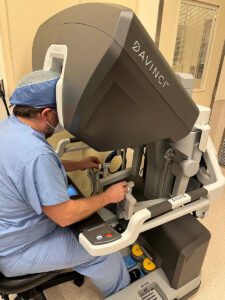By Brenna Wiegand
Legacy Health recently launched a new surgical robotics program at Legacy Silverton Medical Center with the installation of an Intuitive da Vinci Xi Surgical System robot, a versatile robotic system used by surgeons around the world.
This advanced instrumentation allows surgeons to perform delicate and complex operations through a few tiny incisions with increased vision, precision, dexterity and control.

Many operations, once lengthy procedures followed by long hospital stays, are now performed as outpatient procedures, with some patients returning home within a few hours.
“The reason we get so excited about robotics is that it enables us to perform some of the surgeries that we already performed but with greater precision,” Liska Havel M.D., general surgeon with Legacy Health, said.
“This changes the specifics of how minimally invasive our surgeries can be done.
“As surgeons, we love it because it mirrors our own hand movement better than the laparoscopic platform, allowing us to get into smaller spaces,” Havel said. “We can come in from whatever angle and we can turn our ‘wrists’ to perform small movements – that’s a major advance.”
The intuitive technology is designed to mirror the action and motion of the physical hand and for most surgeons, going from open surgery to laparoscopic surgery is a much greater learning curve than going from open surgery to robotic-assisted surgery.
“Open surgery is wonderful in that you do have that feedback from your hands, and they are very soft instruments, but we need to make very big incisions to fit our hands inside and be able to see, resulting in a higher risk of post-operative wound infections and longer hospital stays and recovery times,” Havel said.
“This technology is great for hernia surgeries, because of our capacity to sew,” Havel said. “For bilateral groin hernias, rather than two big, open incisions, patients have just three small incisions on their belly.
“As far as visualization, laparoscopic is 2D while the robotic platform is 3D,” Havel said. “We sit at a little console right next to the patient and put our head into this visualization screen where we are able to have wrist motion that mirrors the way our hands naturally move and then having 3D visualization for us is a huge advance.
“We want people to have best-possible outcomes once they get home so they can get back to their regular, productive lives a lot sooner, and minimally invasive surgery allows us to do that,” Havel said.
“It is all part of our commitment to bring the same standard of care you can get in Portland or Salem home to Silverton.”